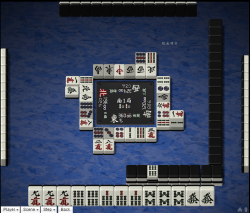Furiten: Difference between revisions
| Line 27: | Line 27: | ||
A riichi declarer is furiten when he has missed a chance to call ron against a winning tile after his riichi declaration. The ignored winning tile may have been a discarded tile or a [[Chankan|tile used to extend a minkou to a shominkan]]. The player will remain furiten for the rest of the hand and thus cannot call ron on any tile. Furiten applies even, if it is a different tile than the ignored one. This rule requires knowledge of all own [[machi|possible waits]]. | A riichi declarer is furiten when he has missed a chance to call ron against a winning tile after his riichi declaration. The ignored winning tile may have been a discarded tile or a [[Chankan|tile used to extend a minkou to a shominkan]]. The player will remain furiten for the rest of the hand and thus cannot call ron on any tile. Furiten applies even, if it is a different tile than the ignored one. This rule requires knowledge of all own [[machi|possible waits]]. | ||
=== | === Turn based furiten === | ||
A player | A player may be in furiten temporarily, when a player has a [[tenpai]] hand, without riichi, declined to call ron. Upon doing so, the player is then temporarily furiten until the next draw-discard process. After making the discard, the player is no longer in furiten. Some rules additionally cancel temporary furiten on any [[naki|tile call]] by any player. | ||
== Strategy == | == Strategy == | ||
Revision as of 09:38, 26 August 2013

Furiten, meaning sacred discard, is a hand status. A player in tenpai is furiten if he could win on an earlier self-discarded tile, or if he has recently ignored to win by ron. Players in furiten may still win by tsumo, but not by ron.
Rules
A player with a tenpai hand is furiten if at least one of the conditions below applies -- discard-based furiten, permanent furiten, or temporary furiten.
- Players in furiten may not win by ron, even if they have a yaku. Declaring ron while in furiten is penalized with a chombo payment.
- Players in furiten may still win by tsumo.
The furiten rule does not consider yaku. Sometimes, a hand can be completed with several tiles, but only some of them provide a yaku, others would produce a yakuless hand. If a yakuless tile appears, it must be ignored, because a winning hand must contain a yaku. The player must remain temporarily furiten.
Discard-based furiten
A player is furiten, if a winning tile is present in one own's discard pile. It does not matter whether this tile would have provided a yaku or not. Tiles turned sideways within open melds are considered part of their discarder's discard pile.
As long as the player has not declared riichi, furiten can be avoided by altering the hand and changing tile waits.
This hand has three different tiles to wait on. If the player has a 2-pin in his own discard pile, he is furiten and may not win by ron on any tile. Even if a 5-pin or 8-pin gets discarded by an opponent, he may not call ron.
Furiten during riichi
A riichi declarer is furiten when he has missed a chance to call ron against a winning tile after his riichi declaration. The ignored winning tile may have been a discarded tile or a tile used to extend a minkou to a shominkan. The player will remain furiten for the rest of the hand and thus cannot call ron on any tile. Furiten applies even, if it is a different tile than the ignored one. This rule requires knowledge of all own possible waits.
Turn based furiten
A player may be in furiten temporarily, when a player has a tenpai hand, without riichi, declined to call ron. Upon doing so, the player is then temporarily furiten until the next draw-discard process. After making the discard, the player is no longer in furiten. Some rules additionally cancel temporary furiten on any tile call by any player.
Strategy
Furiten is often used to defend against opponents. By discarding tiles that are also visible in an opponent's discard pile, a player can avoid a ron call by that opponent.
Dealing with furiten
Sometimes, it may be necessary to deliberately place the hand in furiten. Often times, this is the result of developing the hand and defending simultaneously.